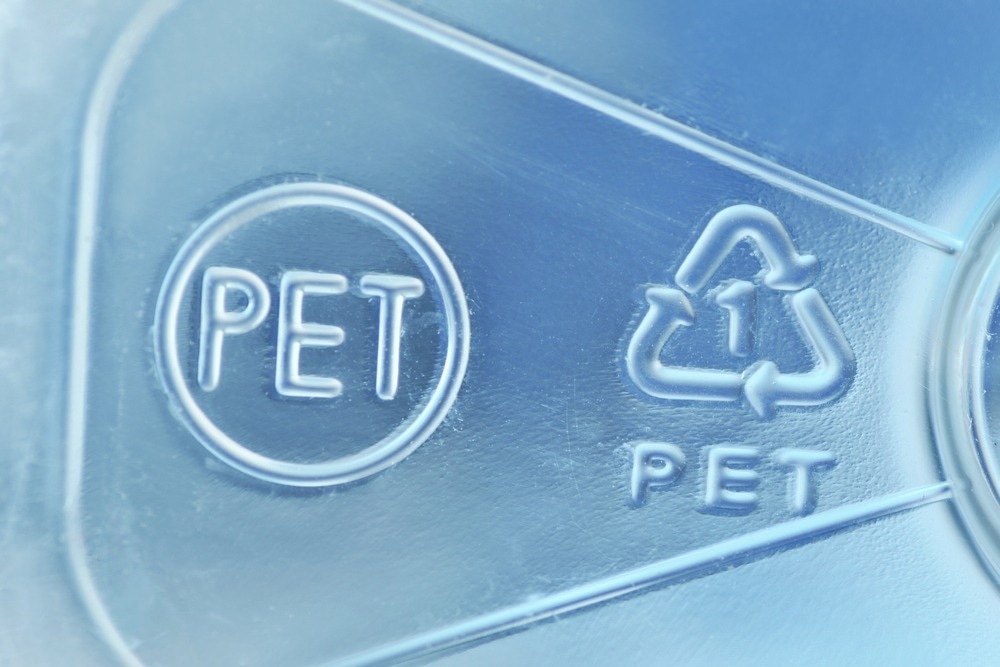Updated by Reginald Davey 11/07/23
Polyethylene terephthalate polyester (PET or PETE)is the most common thermoplastic polyester. It is commonly referred to as “polyester.” Polybutylene (PBT,) another thermoplastic polymer, is chemically similar to PET and is also known as polyester.

Image Credit: CalypsoArt/Shutterstock.com
PBT is the most common resin system used in GRP. In a polyester system, the main difference between PBT and polyethylene terephthalate is that it incorporates chemically unsaturated polyesters and are “free radical polymerized” into a thermoset.
General Properties of Polyester Terephthalate
There are several properties of polyester terephthalate that inform its industrial and commercial uses. PETE is a hard, stiff, strong, and dimensionally stable material that has very low water absorption behavior. It also has good gas barrier properties and good chemical resistance except to alkalis (which hydrolyse it).
PETE varies from an amorphous to relatively higher crystalline state. Its appearance can be colorless and transparent, or in thicker sections, off-whire and opaque.
Polyethylene Terephthalate Films
PETE is widely commercially available in the form of biaxially oriented and thermally stabilized films, usually referred to by their main brand names Mylar, Melinex, or Hostaphan.
Strictly speaking, these names should be used only for this type of film whose properties are different from, and in several respects superior to, those of “ordinary” polyethylene terephthalate (PET) film.
Applications
PETE films are used for capacitors, graphics, film bases, recording tapes, etc. It is also used as fiber in a very wide range of textile and industrial uses (Dacron®, Trevira®, Terylene®).
Uses include both rigid and flexible packaging, textiles, electrical components, bottles, thermoplastic resin, undersea cables, high-pressure gas cylinders, and photovoltaic modules.
Key Properties of Polyethylene Terephthalate
The key properties of Polyethylene Terephthalate Polyester are tabulated below.
Table 1. Key properties
| Chemical Resistance |
| Acids – concentrated |
Good |
| Acids – dilute |
Good |
| Alcohols |
Good |
| Alkalis |
Poor |
| Aromatic hydrocarbons |
Fair |
| Greases and Oils |
Good |
| Halogens |
Good |
| Ketones |
Good |
| Electrical Properties |
| Dielectric constant @ 1 MHz |
3.0 |
| Dielectric strength ( kV.mm-1 ) |
17 |
| Dissipation factor @ 1 kHz |
0.002 |
| Surface resistivity ( Ohm/sq ) |
1013 |
| Volume resistivity ( Ohm.cm ) |
>1014 |
| Mechanical Properties |
| Coefficient of friction |
0.2 - 0.4 |
| Hardness – Rockwell |
M94-101 |
| Izod impact strength ( J.m-1 ) |
13 - 35 |
| Poisson’s ratio |
0.37-0.44 (oriented) |
| Tensile modulus ( GPa ) |
2 - 4 |
| Tensile strength ( MPa ) |
80, for biax film 190 - 260 |
| Physical Properties |
| Density ( g.cm-3 ) |
1.3 - 1.4 |
| Flammability |
Self Extinguishing |
| Limiting oxygen index ( % ) |
21 |
| Refractive index |
1.58 - 1.64 |
| Resistance to Ultra-violet |
Good |
| Water absorption - equilibrium ( % ) |
<0.7 |
| Water absorption - over 24 hours ( % ) |
0.1 |
| Thermal Properties |
| Coefficient of thermal expansion ( x10-6 K-1 ) |
20 - 80 |
| Heat-deflection temperature - 0.45 MPa ( °C ) |
115 |
| Heat-deflection temperature - 1.8 MPa ( °C ) |
80 |
| Lower working temperature ( °C ) |
-40 to -60 |
| Specific heat ( J.K-1.kg-1 ) |
1200 - 1350 |
| Thermal conductivity ( W.m-1.K-1 ) |
0.15 - 0.4 @ 23 |
| Upper working temperature ( °C ) |
115 - 170 |
| Properties Polyethylene Terephthalate Film |
| Property |
|
Value |
| Dielectric Strength @ 25 µm thick |
KV.mm-1 |
300 |
| Dissipation Factor @ 1 MHz |
|
0.016 |
| Elongation at Break |
% |
60 - 165 |
| Initial Tear Strength |
g.µm-1 |
18 - 54 |
Permeability to Carbon Dioxide
@ 25 °C |
x10-13 cm3.cm.cm-2.s-1.Pa-1 |
0.07 - 0.11 |
| Permeability to Hydrogen @ 25 °C |
x10-13 cm3.cm.cm-2.s-1.Pa-1 |
0.45 |
| Permeability to Nitrogen @ 25 °C |
x10-13 cm3.cm.cm-2.s-1.Pa-1 |
0.0034 - 0.0038 |
| Permeability to Oxygen @ 25 °C |
X10-13 cm3.cm.cm-2.s-1.Pa-1 |
0.015 - 0.04 |
| Permeability to Water @ 25 °C |
X10-13 cm3.cm.cm-2.s-1.Pa-1 |
100 - 115 |
| Specific Heat |
KJ.kg-1.K-1 |
1.3 |
| Thermal Conductivity @ 23 °C |
W.m-1.K-1 |
0.13 - 0.15 |
| Properties Polyethylene Terephthalate Fibre |
| Property |
|
Value |
| Material |
|
Medium |
High tenacity |
| Specific Modulus |
cN/tex |
|
700 - 800 |
| Specific Tenacity |
cN/tex |
36 |
70 - 80 |
| Density |
g.cm-3 |
1.39 |
1.39 |
| Extension to break |
% |
36 |
13 - 16 |
| Modulus |
GPa |
|
9 - 11 |
| Shrinkage @ 100 °C |
% |
4 |
1.5 - 6 |
| Tenacity |
GPa |
0.5 |
0.9 - 1.1 |
In Summary
PETE (otherwise known as polyester) is an eminently useful thermoplastic polymer for many applications. This is down to the beneficial physical, chemical, electrical, and thermal properties of polyester terephthalate.
Whilst it possesses several advantages, there are some main disadvantages to using PETE. These include lower heat resistance, potential oxidation of resins, and its lack of biodegradability. However, it continues to be one of the most widely used polymers in the 21st century.
Further Reading and More Information
Goodfellow.com (website) PET – Polyethylene Terephthalate [online] Available at:
https://www.goodfellow.com/catalogue?Material=PET%20-%20Polyethylene%20Terephthalate
Material-properties.org (website) PET – Density – Strength – Melting Point – Thermal Conductivity [online] Available at:
https://material-properties.org/pet-density-strength-melting-point-thermal-conductivity/
Team Xometry (2022) Polyethylene Terephthalate: Uses, Advantages, and Disadvantages [online] xometry.com. Available at:
https://www.xometry.com/resources/materials/polyethylene-terephthalate/
Encylopedia Britannica (2023) Polyethylene terephthalate [online] britannica.com. Available at:
https://www.britannica.com/science/polyethylene-terephthalate